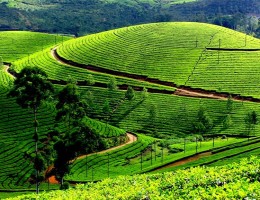IT Services
Travel
Social Organizations
Pincode Search
Kerala Recipes
Matrimonial Sites
About Kerala
Kerala Tourism
Government
Accommodation
News & Media
Contact Numbers
Health Care
Education Corner
Security systems
Kerala Sweets
Fruits
Vegetables
Banana Chips
Sadya
Snacks
Kerala Meals
Banks
Courier Service
Ac Service and Repair
Laptop & Mobile service
Company Registration
Traditional Foods
Famous Foods
Spices
Builders
Cuisine
Palaces
Reservoirs
Sports
Worship
Restaurants
Shopping
Forest
Rivers
Climate
Kerala is a south Indian state located on the Malabar Coast of India. The state has the highest literacy rate in the country and is known for its vibrant culture and natural beauty. It has a tropical climate, which is characterized by high temperatures and high humidity most of the year.
Kerala has a humid and tropical climate, which is strongly influenced by the southwest monsoon. The climate is hot and humid, with temperatures ranging from 82°F to 90°F (28°C to 32°C) and an average annual rainfall of 450-500 mm. The monsoons are between June and September, and the winter months of October to February are the driest.
Kerala gets most of its rainfall from the southwest monsoon. During this season, the state experiences heavy rainfall. This seasonal rainfall is essential for the growth of the state’s agriculture and economy. The northeast monsoon, which blows from October to December, brings a light rainfall to the region.
Kerala also experiences heavy fog in the winter season. The fog is caused by the interaction of the cool air from the Arabian Sea and the warm air from the Indian Ocean. This fog is especially prevalent in the low-lying areas such as the coastal plains.
The summers in Kerala are long and hot, with temperatures reaching up to 40°C. Humidity is also high during this season, making it uncomfortable. The hot and humid climate is beneficial for the growth of tropical plants, as well as for the tourism industry.
Kerala is also vulnerable to natural disasters such as floods and cyclones. The state has experienced several floods in the past, which have caused massive damage to the infrastructure and property. The state also experiences severe cyclones during the monsoon season, which can be very destructive.
Kerala is a beautiful state with a unique climate. Its tropical climate is beneficial for the growth of tropical plants, while its humidity and heavy rainfall are essential for the state’s agriculture and economy. The state also experiences heavy fog in the winter season and is vulnerable to natural disasters such as floods and cyclones.
To keep the climate of Kerala healthy, it is important to take steps to reduce air pollution, conserve water, and protect the environment. This will ensure that the state’s climate remains healthy in the future.
In conclusion, Kerala has a humid and tropical climate, which is strongly influenced by the southwest monsoon. The state receives heavy rainfall in the monsoon season and experiences hot and humid summers. It is also vulnerable to natural disasters such as floods and cyclones. To keep the climate of Kerala healthy, it is important to take steps to reduce air pollution, conserve water, and protect the environment.
Explore Climate
More details
Info Recommended
Click the link below to explore more details about Kerala.



